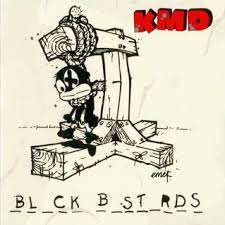In some ways, Bl-ck B-st-rds is an album that’s formed a life of its own. It was shelved in 1994 by Reprise; heavily rumoured to be because of the album title and the cover depiction of a black sambo being hung. It has since had a couple of indie releases, years down the line, and has subsequently become something of a hip hop classic. Not to mention giving the world its first introduction to the legendary hip hop crusader (and hip hop’s last true enigma), Zev Love X, aka MF Doom. From listening to a youthful young spark such as Doom on this album, his production work rings true of what’s to come in later years. Not to mention the Supervillain’s love of samples from cartoons and films of yesteryear, his whimsical flows and a strong influence of superheroes pervades throughout this record.
Listening back to the album 21 years on, Bl-ck B-st-rds still sounds fresh, whilst remaining very much of its time. It sits very well amongst the pantheon of the golden era of hip hop between the late 80s and mid-90s. There’s unabashed, youthful creativity, combined with lyrical waxes on how tough it is to grow up being young and black in America. There’s also a tinge of poignancy with this LP concerning KMD member Subroc, who shortly passed away shortly after establishing his early potential as a producer and MC on this album. To add insult to injury, Reprise’s decision to shelve the LP would partly contribute to KMD’s eventual demise, thanks to the subsequent controversy that followed.
What has changed 21 years on is the expansion of an extra CD (reissue, repackage, repackage etc.) with instrumentals, album mixes, alternate vocal takes and a remix. As people who first heard Bl-ck B-st-rds at the time will attest, the album still has the vigour and bouncy effervescence of youth, with a raw, black power undertone that’s felt throughout. The charm of the record lies in KMD not trying too hard to be perfectionists. If they had, the record would have suffered as a result and would subsequently have lost its joyfulness – its very essence.
Bl-ck B-st-rds uses the 1970 spoken-word album Blue Guerrilla by Gylan Kain as a major reference point. It’s demonstrated in at least two songs, including ‘What A Nigga Know’ and ‘Get U Now’. Opening track ‘Garbage Day #3’ is a mash-up of television samples – a glimpse perhaps of MF Doom’s love of skits and sampling, a style, which would later become more prominent. There’s also a generous portion of jazz and R&B throughout.
Bl-ck B-st-rds received mixed reviews back in the day for being not as strong as its counterparts by A Tribe Called Quest or De La Soul. But thankfully, the album has aged well. It’s only with the benefit of hindsight can we truly judge how a record has fared musically and how good it actually is. History has shown that as long as there’s no more reissues – three is quite enough thanks – Bl-ck B-st-rds is a modern day classic. It’s an album we could only wish came out in 2015.
<div class="fb-comments" data-href="http://thequietus.com/articles/18618-kmd-bl_ck-b_st_rds-review” data-width="550">


